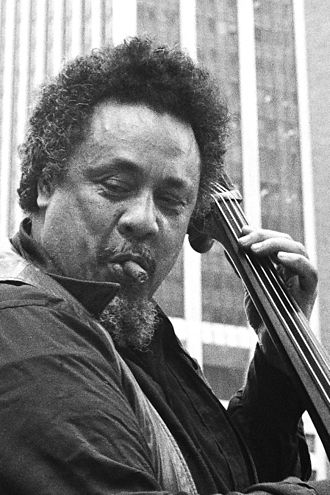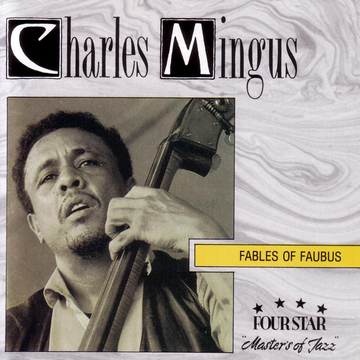
Mingus, Charles
Charles Mingus was born in Nogales, Arizona. His father, Charles Mingus Sr., was a sergeant in the U.S. Army. Mingus was largely raised in the Watts area of Los Angeles. His maternal grandfather was a Chinese British subject from Hong Kong, and his maternal grandmother was an African-American from the southern United States. Mingus was the third great-grandson of the family’s founding patriarch who was, by most accounts, a German immigrant. His ancestors included German American, African American, and Native American.
In Mingus’s autobiography Beneath the Underdog his mother was described as “the daughter of an English/Chinese man and a South-American woman”, and his father was the son “of a black farm worker and a Swedish woman”. Charles Mingus Sr. claims to have been raised by his mother and her husband as a white person until he was fourteen, when his mother revealed to her family that the child’s true father was a black slave, after which he had to run away from his family and live on his own. The autobiography does not confirm whether Charles Mingus Sr. or Mingus himself believed this story was true, or whether it was merely an embellished version of the Mingus family’s lineage.
His mother allowed only church-related music in their home, but Mingus developed an early love for other music, especially Duke Ellington. He studied trombone, and later cello, although he was unable to follow the cello professionally because, at the time, it was nearly impossible for a black musician to make a career of classical music, and the cello was not yet accepted as a jazz instrument. Despite this, Mingus was still attached to the cello; as he studied bass with Red Callender in the late 1930s, Callender even commented that the cello was still Mingus’s main instrument. In Beneath the Underdog, Mingus states that he did not actually start learning bass until Buddy Collette accepted him into his swing band under the stipulation that he be the band’s bass player.
Due to a poor education, the young Mingus could not read musical notation quickly enough to join the local youth orchestra. This had a serious impact on his early musical experiences, leaving him feeling ostracized from the classical music world. These early experiences, in addition to his lifelong confrontations with racism, were reflected in his music, which often focused on themes of racism, discrimination and (in)justice.
Much of the cello technique he learned was applicable to double bass when he took up the instrument in high school. He studied for five years with Herman Reinshagen, principal bassist of the New York Philharmonic, and compositional techniques with Lloyd Reese. Throughout much of his career, he played a bass made in 1927 by the German maker Ernst Heinrich Roth.
Beginning in his teen years, Mingus was writing quite advanced pieces; many are similar to Third Stream because they incorporate elements of classical music. A number of them were recorded in 1960 with conductor Gunther Schuller, and released as Pre-Bird, referring to Charlie “Bird” Parker; Mingus was one of many musicians whose perspectives on music were altered by Parker into “pre- and post-Bird” eras.
Mingus gained a reputation as a bass prodigy. His first major professional job was playing with former Ellington clarinetist Barney Bigard. He toured with Louis Armstrong in 1943, and by early 1945 was recording in Los Angeles in a band led by Russell Jacquet, which also included Teddy Edwards, Maurice Simon, Bill Davis, and Chico Hamilton, and in May that year, in Hollywood, again with Teddy Edwards, in a band led by Howard McGhee.
He then played with Lionel Hampton’s band in the late 1940s; Hampton performed and recorded several of Mingus’s pieces. A popular trio of Mingus, Red Norvo and Tal Farlow in 1950 and 1951 received considerable acclaim, but Mingus’s race caused problems with club owners and he left the group. Mingus was briefly a member of Ellington’s band in 1953, as a substitute for bassist Wendell Marshall. Mingus’s notorious temper led to his being one of the few musicians personally fired by Ellington (Bubber Miley and drummer Bobby Durham are among the others), after a back-stage fight between Mingus and Juan Tizol.
Also in the early 1950s, before attaining commercial recognition as a bandleader, Mingus played gigs with Charlie Parker, whose compositions and improvisations greatly inspired and influenced him. Mingus considered Parker the greatest genius and innovator in jazz history, but he had a love-hate relationship with Parker’s legacy. Mingus blamed the Parker mythology for a derivative crop of pretenders to Parker’s throne. He was also conflicted and sometimes disgusted by Parker’s self-destructive habits and the romanticized lure of drug addiction they offered to other jazz musicians. In response to the many sax players who imitated Parker, Mingus titled a song “If Charlie Parker Were a Gunslinger, There’d Be a Whole Lot of Dead Copycats” (released on Mingus Dynasty as “Gunslinging Bird”).
Mingus was married four times. His wives were Jeanne Gross, Lucille (Celia) Germanis, Judy Starkey, and Susan Graham Ungaro.
In 1961, Mingus spent time staying at the house of his mother’s sister (Louise) and her husband, Fess Williams in Jamaica, Queens. Subsequently, Mingus invited Williams to play at the 1962 Town Hall Concert.
In 1952, Mingus co-founded Debut Records with Max Roach so he could conduct his recording career as he saw fit. The name originated from his desire to document unrecorded young musicians. Despite this, the best-known recording the company issued was of the most prominent figures in bebop. On May 15, 1953, Mingus joined Dizzy Gillespie, Parker, Bud Powell, and Roach for a concert at Massey Hall in Toronto, which is the last recorded documentation of Gillespie and Parker playing together. After the event, Mingus chose to overdub his barely audible bass part back in New York; the original version was issued later. The two 10″ albums of the Massey Hall concert (one featured the trio of Powell, Mingus and Roach) were among Debut Records’ earliest releases. Mingus may have objected to the way the major record companies treated musicians, but Gillespie once commented that he did not receive any royalties “for years and years” for his Massey Hall appearance. The records, however, are often regarded as among the finest live jazz recordings.
One story has it that Mingus was involved in a notorious incident while playing a 1955 club date billed as a “reunion” with Parker, Powell, and Roach. Powell, who suffered from alcoholism and mental illness (possibly exacerbated by a severe police beating and electroshock treatments), had to be helped from the stage, unable to play or speak coherently. As Powell’s incapacitation became apparent, Parker stood in one spot at a microphone, chanting “Bud Powell … Bud Powell …” as if beseeching Powell’s return. Allegedly, Parker continued this incantation for several minutes after Powell’s departure, to his own amusement and Mingus’s exasperation. Mingus took another microphone and announced to the crowd, “Ladies and Gentlemen, please don’t associate me with any of this. This is not jazz. These are sick people.” This was Parker’s last public performance; about a week later he died after years of substance abuse.
Mingus often worked with a mid-sized ensemble (around 8–10 members) of rotating musicians known as the Jazz Workshop. Mingus broke new ground, constantly demanding that his musicians be able to explore and develop their perceptions on the spot. Those who joined the Workshop (or Sweatshops as they were colorfully dubbed by the musicians) included Pepper Adams, Jaki Byard, Booker Ervin, John Handy, Jimmy Knepper, Charles McPherson and Horace Parlan. Mingus shaped these musicians into a cohesive improvisational machine that in many ways anticipated free jazz. Some musicians dubbed the workshop a “university” for jazz.
Mingus’s pace slowed somewhat in the late 1960s and early 1970s. In 1974, after his 1970 sextet with Charles McPherson, Eddie Preston and Bobby Jones disbanded, he formed a quintet with Richmond, pianist Don Pullen, trumpeter Jack Walrath and saxophonist George Adams. They recorded two well-received albums, Changes One and Changes Two. Mingus also played with Charles McPherson in many of his groups during this time. Cumbia and Jazz Fusion in 1976 sought to blend Colombian music (the “Cumbia” of the title) with more traditional jazz forms. In 1971, Mingus taught for a semester at the University at Buffalo, The State University of New York as the Slee Professor of Music.
By the mid-1970s, Mingus was suffering from amyotrophic lateral sclerosis (ALS). His once formidable bass technique declined until he could no longer play the instrument. He continued composing, however, and supervised a number of recordings before his death. At the time of his death, he was working with Joni Mitchell on an album eventually titled Mingus, which included lyrics added by Mitchell to his compositions, including “Goodbye Pork Pie Hat“. The album featured the talents of Wayne Shorter, Herbie Hancock, and another influential bassist and composer, Jaco Pastorius.
Mingus died, aged 56, in Cuernavaca, Mexico, where he had traveled for treatment and convalescence. His ashes were scattered in the Ganges River.
